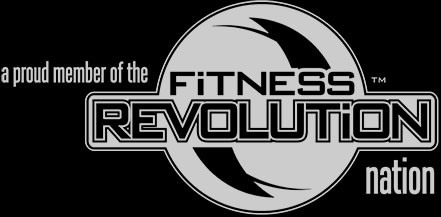Author: adrensf
Sharpen the Sword – episode 2: Pre and Post training Nutrition
Random Thoughts – May 2016
Neil Platt ~
I am an avid reader and I have two must-read book recommendations: The Matheny Manifesto is an absolute must read for anyone involved with youth sports. It is written by St. Louis Cardinals’ coach, Mike Matheny.  Whether you are a parent, coach, or trainer it is an eye-opener that really hammers home the point of youth sports: IT IS ALL ABOUT THE KIDS! Another book that blew my mind was Legacy, a fantastic read that focuses on leadership. The central theme is the leadership structure within the New Zealand All Blacks program and how they have used this structure to dominate the rugby world. Need a knowledge bomb or two? Check out these two books.
Whether you are a parent, coach, or trainer it is an eye-opener that really hammers home the point of youth sports: IT IS ALL ABOUT THE KIDS! Another book that blew my mind was Legacy, a fantastic read that focuses on leadership. The central theme is the leadership structure within the New Zealand All Blacks program and how they have used this structure to dominate the rugby world. Need a knowledge bomb or two? Check out these two books.
Have you ever wondered “what is athleticism?” Yeah, me too. Here is a quick comparison of two of the NBA’s finest: Russell Westbrook and Steph Curry. Who is the better athlete? At first glance, Westbrook is by the far the better athlete. He’s faster, stronger and can jump through the roof. However, Westbrook’s career accomplishments fail to match what Curry has done. When you really dive down the rabbit-hole of what makes a great athlete, you have to consider aspects like reaction, focus, feel for the game, and coordination.
In-season training is a tool in the long-term development of an athlete that hardly anyone takes advantage of. Athletes of all ages spend countless amounts of blood, sweat, and tears, not to mention hundreds if not thousands of dollars, on their off-season training only to see diminished returns from their investment as they move through their season. Rather than waste all of this effort, add some structured training to your in-season routine. In-season training is generally done at a lower intensity with a shorter duration. The goal isn’t to make vast improvements during the season, it is to keep the improvements that were earned during the off-season.
Single-leg glute training hardly gets enough attention. Everyone is concerned with big squats and deadlifts, which are great, but not the whole picture. So much of our time is spent in a single leg position, yet we hardly train for it. Try adding some single leg hip extension, flexion, and abduction/adduction exercises to your training and see if you notice a difference, Stephen Curry certainly did.
The best diet ever is…the one that works best for you and the one you can follow for the long term. The diet industry is pretty comparable to the wi ld west where anyone can put anything out there and claim is the secret to success. Instead of chasing the next diet craze that promises six pack abs in 30 days, try sticking to a diet that is well balanced, consisting of healthy fats (nuts & oils), fruits & veggies, lean proteins (chicken, lean beef, fish, eggs), minimally processed carbohydrates, and the occasional sweet treat. Remove all of the complex myths that most diets use to confuse you and just focus on the basics!
ld west where anyone can put anything out there and claim is the secret to success. Instead of chasing the next diet craze that promises six pack abs in 30 days, try sticking to a diet that is well balanced, consisting of healthy fats (nuts & oils), fruits & veggies, lean proteins (chicken, lean beef, fish, eggs), minimally processed carbohydrates, and the occasional sweet treat. Remove all of the complex myths that most diets use to confuse you and just focus on the basics!
Brian Macdonald ~
Adding muscle is the best way to burn fat, and here’s why: Lifting weights allows you to sustain a higher metabolism after your training has finished, unlike never ending cardio circuits which will spike your metabolism while you are doing it, but will return to normal shortly after training has ceased. It has been estimated that metabolic rate can be elevated for as long as 39 hours after an intense bout of resistance training, so you are burning calories at a higher rate for a longer rate. Also, more lean muscle = higher metabolic rate. Think of it as the more lean muscle you have, the hotter your “metabolic fire” will burn. The cardio/starvation approach is not going to be the best means to achieving the goal of a better physique. Reasonable amounts of cardio/conditioning are perfectly healthy and highly encouraged for cardiovascular health, but if a true change in your overall physique is the set goal, consider a sound resistance training program paired with equally sound nutrition containing sufficient quantities of macronutrients to support muscle growth is the way to go.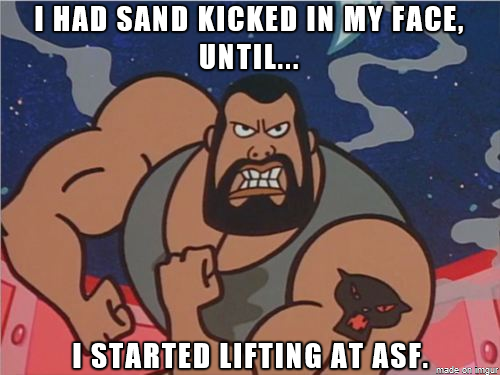
Peri-workout nutrition is a hot topic in sport nutrition circles right now. Consuming food prior to exercising will help sustain energy, prevent the breakdown of muscle mass, boost performance, and aid in the recovery process. Some sort of mixed meal, containing protein and some sort of carbohydrate, a few hours prior to exercise will go a long way in achieving these goals. Protein will help maintain and potentially increase muscle size, help to reduce the severity of muscle damage, and increase your amino acid profile within the bloodstream which aids in your body’s muscle building ability. Carbohydrates can simply be viewed as fuel for your workout as well as stabilizing blood sugar levels. They also help to preserve muscle and liver glycogen which will help prevent the breakdown of muscle. Lastly, carbs will help boost insulin levels which will help in protein synthesis, also a reason to eat a mixed meal including these two macros. Think of something such as fruit, oats, or rice for your carb content. Hopefully this will inspire you to consider the importance of fueling your body and make a difference in your workouts.
Another controversial topic in health and wellness is detoxing or cleanses. When it comes down to it, our body is extremely efficient at cleansing itself, that is assuming that we treat it right. If we simply boost our natural detoxification systems within our bodies and not abuse them, we are perfectly capable of clearing unwanted toxins and chemicals, free of charge. Our liver, kidneys and lymphatic system do a tremendous job of clearing out the “garbage” from our multiple cellular processes. [For more info, please check out this fantastic article from the incredibly knowledgeable team at Precision Nutrition on whether detox diets are actually good for you.]
Brigit Reder ~
Creatine… Just for the guys right? Wrong. Creatine is an organic acid that every human produces. Simply put, it helps supply energy to all cells in the body, especially 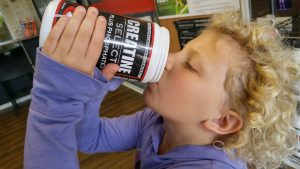 muscle cells. Its not specific to only male muscle cells and incompatible with those of females. The benefits of taking creatine regularly are worth considering when trying to add that next level to your training, potentially put on some extra lean muscle mass, enhance recovery, and exert one more powerful sprint rep. Again, it does not matter male or female… if you’re training goals are not being met with current balanced nutrition, recovery, and exercise protocol, consider putting some thought into adding Creatine as part of your routine.
muscle cells. Its not specific to only male muscle cells and incompatible with those of females. The benefits of taking creatine regularly are worth considering when trying to add that next level to your training, potentially put on some extra lean muscle mass, enhance recovery, and exert one more powerful sprint rep. Again, it does not matter male or female… if you’re training goals are not being met with current balanced nutrition, recovery, and exercise protocol, consider putting some thought into adding Creatine as part of your routine.
GPS in sports. Something not spoken of frequently in the media or on your hour of SportsCenter every morning. However, it’s an integral part in professional sporting arenas and even most top college programs. Especially within soccer, rugby, and even basketball. GPS and heart-rate monitor use, in combination, during games and training help strength and conditioning coaches monitor athlete’s output and therefore aid in recovery programming. GPS tracks max output sprints, total mileage covered, where movement is taking place on the field or court, quantifying amounts of acceleration and deceleration within a game, and using this information to analyze the physical demands of athletes in their positions and sports. Incredibly useful tool, but underused based on high cost.
Leadership tends to be a term thrown around among coaches, teachers, and businesses alike. Everyone seems to have their own definition of what a leader is… naturally capable of captivating an audience and influencing, or the opposite, skills and attributes that were learned over time through study of literature or interacting with groups of people. No right or wrong, simply just different styles of leadership. Ultimately leadership is a powerful tool. The ability to lead and organize a group of people to share a common belief or goal, and then find a way to identify and solve problems in an ongoing journey. If you’re identified as leader in your workplace, sport, school, whatever arena… are you positively influencing and leading those around you towards the greater good or goal?
Tony Poggiali ~
The time I spend with my daughter and all the kids at ASF is such a two way street; I am sure that I learn more from them than they learn for me.
Our coaches are always behind the scenes getting better so you can better. There is a stigma that all we do is lift weights, wear t-shirts and shorts (which we do), and just show up to write workouts and administer a bunch of drills. We take every bit as much pride in mastering our craft as any other professional. Ask any of us how much time is spent on continuing education and you may be surprised how serious we take our vocation. There is SO much that we know, but even more that we do NOT know. It makes the path to mastery extremely fun.
Short of non-stop traveling, I am convinced that the world can be found in books.
Are smart phones really making us smarter? It feels like they are making us dumber.
The training industry gap is widening. The good coaches are becoming great, the great coaches are becoming elite, the pioneers, and everyone else is poor or average and will eventually have no more business or leave the industry. Consumers are getting smarter, more skeptical and becoming informed. If you are not getting better, by default, you are getting worse.
I love to make mistakes. It has taken me a long time to get over the word failure. I am messing things up pretty much every week but have changed my mindset to accept that mistakes are the greatest teachers.
After 28 years of training/coaching, I am still having fun. When it ceases to be fun, I am done.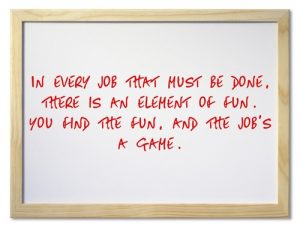
I think the next wave of research (actually, it is already here) will focus on our relationship with the billions of critters that live inside of us, known as the microbiome. They may be responsible for….everything that goes wrong (and right) within us. Stay tuned.
Sharpen the Sword #1 – Self myofascial release
Internship 101
My experience at Adrenaline Sports & Fitness was everything I could have asked for and more. I’m a Health Promotion & Education major with a focus in exercise & fitness at the University of Cincinnati and interning at Adrenaline was part of my education. I wasn’t sure what to expect because gyms can be intimidating to newbies but I could quickly tell this was not like any other gym. From the beginning, Tony and the coaches took me under their wing and showed me everything from how to be a good coach to setting up strength protocols. Everyday, I observed athletes improving their strength and athletic ability while having fun. I participated in the M2 classes where the workouts pushed me to my limits and by doing that, I have more energy, stamina and I’m healthier overall. In the short amount of time that I spent at Adrenaline, I became a better person thanks to Tony and the coaches. Anyone who trains at Adrenaline knows how lucky they are to have a great atmosphere and caring coaches to push them to be their best!
-Claire Neiswander
From my time at Adrenaline Sports and Fitness, I have learned a lot about training athletes of different levels, ages, sports, etc. When working with these athletes you may have to slightly alter exercises, drills, and interactions to best suit each individual athlete. Building a relationship with an athlete is one of the things you cannot learn from a textbook, yet having this skill is key to this career. Highlighting strengths and addressing differences in the athletes are key to building a relationship and effectively instructing. Some athletes may be overwhelmed when first starting to train, so finding one or two things to work on at each session is more beneficial than having five or six things. In addition to learning about interacting and coaching athletes, I learned a lot of exercises and drills for various purposes (speed, power, agility, etc.). The training was more ideal for athletes, mimicking movements that would happen in the sport rather than performing movements that are not realistic. I believe that gaining this experience from ASF will benefit me in the future because I got to observe, participate and learn things I would not necessarily learn in a classroom or textbook.
My journey from professional athlete to coach – Brigit Reder
“Passion is a huge prerequisite to winning. It makes you willing to jump through hoops, go through all the ups and downs and everything in between to reach your goal.” – Kerri Walsh, beach volleyball Olympic gold medalist
Professional sports… supposed to be glamorous, high rolling paychecks, highlight reels making SportsCenter, and agents going above and beyond for their athletes and contract negotiations. This is the case for the majority of pro athletes, especially those in the MLB, NBA, NFL, NHL, WNBA, and for the most part, any Olympic Athlete.
However, what is the reality for all those other professional athletes? The ones who aren’t on ESPN every week or making the headlines of various magazines and social media sites? Are they even considered professional athletes; you’ve got to be making the big money to be considered a Pro right?
This was one of the prominent questions that ran through my mind for the last 3 years and even still today. Questioning if the sweat, extra work, sacrifice of social life and financial 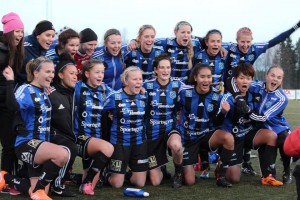 stability was worth it. I was never going to be on major sports channels with my games being broadcast live, I was not going to be paid hundreds of thousands of dollars, let alone an annual salary. I was not going to have the option of playing near my hometown in front of family and friends, or to even make weekend trips to friends’ weddings or family events. So why? Why did I continually work my body, mind, and heart to continue playing soccer? Doesn’t seem worth it for all the things I had to give up or miss out on. Fortunately enough, the love and passion for the game continually motivated me and forced my mind out of a progressive pessimistic tornado. There is a choice just about any athlete has to make: Is the sacrifice, the pain, the sweat, the tears, the ups and downs… worth the satisfaction of reaching a goal? Is it worth the grind in hopes of holding up that trophy, getting a contract renewal, seeing the young girls attending every game absolutely idolizing every move you make, or the simple knowledge that you made a difference in a teammate or coaches life because of a simple encouraging statement?
stability was worth it. I was never going to be on major sports channels with my games being broadcast live, I was not going to be paid hundreds of thousands of dollars, let alone an annual salary. I was not going to have the option of playing near my hometown in front of family and friends, or to even make weekend trips to friends’ weddings or family events. So why? Why did I continually work my body, mind, and heart to continue playing soccer? Doesn’t seem worth it for all the things I had to give up or miss out on. Fortunately enough, the love and passion for the game continually motivated me and forced my mind out of a progressive pessimistic tornado. There is a choice just about any athlete has to make: Is the sacrifice, the pain, the sweat, the tears, the ups and downs… worth the satisfaction of reaching a goal? Is it worth the grind in hopes of holding up that trophy, getting a contract renewal, seeing the young girls attending every game absolutely idolizing every move you make, or the simple knowledge that you made a difference in a teammate or coaches life because of a simple encouraging statement?
The answer… ABSOLUTELY!
The journey to play professionally in the states and overseas in Sweden was not easy. It had many peaks and valleys, hardships and setbacks, times of doubt and times of pure grinding motivation to prove everyone wrong. But it was it worth every second! There’s no easy way to explain the full scope of the experience. New countries explored, new friendships and relationships created, the chance to only focus on preparing your mind and body for the game each week, the new cultures experienced and values learned. The immense appreciation of the place you come from and the people who helped make your dreams a reality. This is just a mere glimpse of the full snapshot. Growth is the word I would choose to sum up my journey and the years playing overseas, as a young adult, a soccer player, a sister, a daughter, a friend, a coach, a teammate. When you’re will is tested, when you miss family and friends, when you question if it’s all worth it… you find out what the depths of your heart and soul will hold.
I realized how deeply rooted my passion of the game was within me. I realized how much I was not alone even when it felt like it at times. I had family, friends, an ASF team, my faith and hope that kept me going when I simply wanted to give up.
To any young girl dreaming of playing at the next level, whether that’s high school, college or professionally, I encourage you to take on the challenge fu ll force. Ask for help when you need it, put in the work and extra hours of practice. Understand the sacrifice is worth it in the end because the amount of lasting friendships created, life lessons and values learned from the growing process, is priceless. My chapter of playing professionally is complete, even though Sweden and my team will always have a piece of my heart and life. But now I have the blessing and opportunity of coaching and supporting young athletes in the pursuit of life journeys. I consider myself lucky to have the chance to coach at Adrenaline and to return to my alma mater of Lakota West to pay it back into the lives of those high school girls. I thank everyone who played a part in my success and my journey, who pushed and challenged me to reach past limits, pick me back up when I thought I was done, and support me in my very geographically sporadic path.
ll force. Ask for help when you need it, put in the work and extra hours of practice. Understand the sacrifice is worth it in the end because the amount of lasting friendships created, life lessons and values learned from the growing process, is priceless. My chapter of playing professionally is complete, even though Sweden and my team will always have a piece of my heart and life. But now I have the blessing and opportunity of coaching and supporting young athletes in the pursuit of life journeys. I consider myself lucky to have the chance to coach at Adrenaline and to return to my alma mater of Lakota West to pay it back into the lives of those high school girls. I thank everyone who played a part in my success and my journey, who pushed and challenged me to reach past limits, pick me back up when I thought I was done, and support me in my very geographically sporadic path.
You either get better or you get worse – Neil Platt
We all have goals that we want to accomplish in life. Whether it’s climbing the career ladder, losing weight, or being a better spouse/friend/person, we all have these aspirations. Having a clear vision of where you are going in life is absolutely essential to your overall success. I recently covered a series of topics in a three-part mini series that I feel to be very important. Creating and practicing healthy habits on a daily basis will help keep you on track. Having a set of core values you live by is crucial to staying grounded and living a life of which you can be proud. A healthy dose of a positive attitude will be the driving force behind your journey to reach your ultimate goals. Having all three of these characteristics work in harmony will be the life-blood of your ultimate success.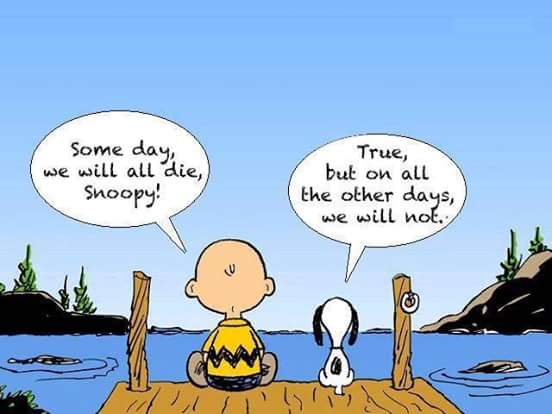
Some of the goals we have can seem daunting. Let’s say you have been sedentary for the past few years. You have been wrapped up in your work, your family, and everything else except your health. You have really let yourself slide and the negative habits of poor eating, too much stress, and not enough sleep have really taken their toll. As with most things, something has happened in your life and you have decided to make a change. You’re going to get your life back in order and lose 40 pounds. You go out and get a fancy new gym membership, some sweet training shoes, and some fresh new gym wear. You’re ready to rock and roll. But wait, it’s Thursday. You can’t start anything on a Thursday, might as well wait until Monday and start fresh.
Monday rolls around and you come out of the gates on fire. You’re eating nothing but salad for three meals a day, hitting the gym, and getting to bed on time. You’re going balls-to-the-wall, 100% intensity and having fun with it. The novelty of this journey is still strong and nothing can stop you now.
Next Monday rolls around and…s#@t. “I’m tired, sore, and all of these salads kinda suck“. Before you know it, week two was not as productive as week one and you’re right back into a rut. You’re thinking, “Where did I go wrong? I have everything I need, I picked up all these awesome workout ideas from the Biggest Loser, I was so motivated, and now this. WTF?!?”
It is estimated that about 80-90% of New Years’ resolutions fail to produce lasting results.
Why is this?
I don’t claim to know all of the reasons (psychology is not my forte) why most attempted lifestyle changes are abandoned after a short amount of time but I have a few ideas.
More often than not, when most people start a new habit they pick something so big they are destined to fail, just like in our example above. Not only do people tend to think way too big when it 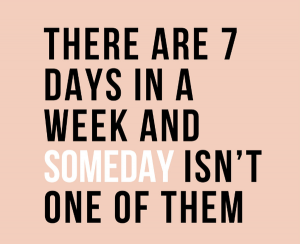 comes to changing their lives, they also come at it with too much intensity. The intention is there but they focus all of their energy on this one topic and attack it with relentless enthusiasm. The initial week or two are a breeze due to the novelty of the venture. There is a bit of excitement from being a new person. However, the thrill of adventure inevitably wears off as you realize the unforeseen complexities that undoubtedly come with creating a new habit. You burn out and quit before you have a chance to start noticing any tangible results. The cycle of grandiose plans to change your life followed by the eventual failure to see it through perpetuates itself until you’re truly at your whit’s end with nowhere to turn.
comes to changing their lives, they also come at it with too much intensity. The intention is there but they focus all of their energy on this one topic and attack it with relentless enthusiasm. The initial week or two are a breeze due to the novelty of the venture. There is a bit of excitement from being a new person. However, the thrill of adventure inevitably wears off as you realize the unforeseen complexities that undoubtedly come with creating a new habit. You burn out and quit before you have a chance to start noticing any tangible results. The cycle of grandiose plans to change your life followed by the eventual failure to see it through perpetuates itself until you’re truly at your whit’s end with nowhere to turn.
So, how do we break the pattern and finally start changing our lives for the better? It starts with a new way of thinking.
Rather than looking at your life and thinking you need to make massive, large scale changes, I want you to think of it a little differently. Instead of taking one aspect of your life and attacking it with 100% effort, I want you to take inventory of everything you do and improve on these by just 1%. Put another way for all of you math whiz’s:
Instead of improving on 1 thing by 100%, improve on 100 things by just 1%.
When you break things down into much smaller, easier to accomplish tasks you’re setting yourself up for success. Just setting a goal of losing 40 pounds is almost a guaranteed way to fail. Rather than setting the damn-near unattainable goal, simply think about sleeping a little better, eating one more vegetable a day, being just a little more active today than you were yesterday, and drinking one more glass of water. When you’re dialed into what you’re doing today and doing each of those things just 1% better, your long-term success is almost a guarantee. You’ll accomplish your big-rock goals in less time and with less effort than you would have otherwise. Shifting your focus from your major ambitions to your daily tasks will leave you feeling less stressed and more accomplished at the end of the day. Rather than having the weight (literally) of a 40 pound weight loss hanging over your head every night, you’ll have the enjoyment of knowing you took a step in the right direction.
You may be thinking there is no way making a 1% change in anything will lead to any tangible results. However, life is full of examples where 1% makes all the difference. The difference between placing in an Olympic event and going home empty-handed is typically in the tenths of seconds (or the equivalent for longer events), a 1% difference in interest rates on a student loan can be in the thousands of dollars, and the difference between being human and a chimpanzee is about a 1% genetic difference. When you add up all of the improvements you make by doing 100 things just 1% better you will see the results. Al Pacino in Any Given Sunday nailed it. If you haven’t seen the movie or didn’t watch the clip, the brief summary is opportunities for small improvements are all around us at all times. The difference between someone who is successful and someone who is not is the willingness to take advantage of these small opportunities and work at them every day. Don’t focus on breaking a 50 yard touchdown run. Focus on fighting for the inch in front of you and the rest will take care of itself.
I was recently reading an article and I can’t remember where it was so I apologize for not being able to give credit to the author but he wrote something that has had a profound change on the way I now approach things. He was talking about habit change and why most people fail and his point is this:
Intensity is for Amateurs, Consistency is for Pros.
I absolutely love that statement. I am in the process of making some lifestyle changes and every time I want to get ahead of myself or I get down about a recent failure, I remind myself of those words. It has really helps me keep everything in context and it is a great reminder that anything worth doing will take time, effort, and consistency.
Proper shoewear for athletic skill – Brian Macdonald
Throughout my athletic career and my time as a strength and conditioning coach, I’ve learned the incredible importance of footwear when it comes to performance and injury prevention. Since I have become a strength and conditioning professional, this is an area that needs to be addressed the most with my athletes. For whatever reason, my athletes, and people in general, tend to ignore the labels that shoe departments place over a section (running, training, hiking, etc.). This post will focus specifically on the difference between a running and training shoe, simply because roughly 85% of my athletes wear a running shoe to do speed and agility drills expecting optimal performance, and hopefully serve as a guide for the next trip to purchase a new pair of kicks. For clarity, “running” shoe implies a shoe designed for linear running.
Here is my thought process when purchasing a pair of shoes to start the discussion. Prior to even looking at shoes, I always make sure I go in understanding for what purpose I am buying them. Considering my profession, I go straight to the training section 98% of the time. I am fully aware of the demands that will be placed on these shoes. Unfortunately, many go in simply looking for the coolest looking pair of shoes they see, rather than even bothering with the function of the shoe, and end up wearing a shoe made for distance runners instead of a design to perform aggressive speed and agility drills involving intense acceleration, deceleration, and change of direction. If I see one more kid walk in to our facility with Nike Roshes on, I am going to explode! Shoes like the Nike Roshe have zero business being worn during intense bouts of speed and agility skill work. I have literally given my shoes to one of my athletes for the hour simply because I was so afraid he was going to possibly injure himself as a result of the shoes he decided to wear. For many of my athletes, footwear is what’s keeping them from performing at optimal levels simply due to the fact their shoes are unable to handle the forces being applied to them.
Let’s start with understanding the function of a running shoe. The term running shoe, as mentioned above, implies linear distance running. Many throw speed and agility under the umbrella of general running which is a huge mistake. The shoe is specifically designed to meet the demands a distance runner will experience, so expect more qualities that will aide in absorbing the constant impact a runner endures throughout their training. There are obviously at least a dozen other factors that go into picking out running shoes, which could be a blog post in itself, but I won’t dive into that in this one. Now lets discuss the characteristics and function of a training shoe. They are designed to to support higher speeds involving acceleration, deceleration, and change of direction, in multiple directions. In short, they have a greater amount of lateral support that really locks the foot in for intense bouts of speed and agility drills thus aiding in the prevention of injuries, particularly lateral ankle sprains, and allowing for maximum control. Here is one way to look at it when shopping for training shoes: Higher the sole height = less lateral stability; shorter sole height = more lateral control. If there is still a lack of clarity, simply visit Nike’s website. They do a phenomenal job at guiding you towards the right shoe by being as specific as possible with their tabs. For example, I want to order a new training shoe for my speed and agility training. I go to the Nike homepage, click on “men”, and categories are immediately laid out for you. Click on the “training & gym” tab, and you will instantly notice there are subcategories laid out whether I want something fast and responsive with a low profile, more cushioning for added comfort, or something that has maximum stability and more of a flat profile for something such as weightlifting. If you are looking for running shoes, they get even more specific with subcategories. If you simply take the time to research a bit, they make your shopping experience as simple as possible. Below are pictures to help put a visual with what I am describing. First is an example of the Nike Zoom Speed Trainer 3, which I happen to wear and love. There are two views of the side profile and the bottom. Second is the Nike Zoom Pegasus 32. Pay attention particularly to the obvious differences in the sole thickness and shape clearly showing what each shoe is designed for.

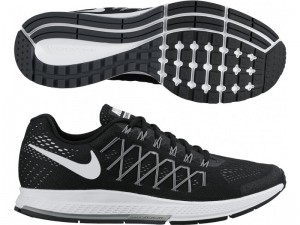
Hopefully this post will steer you in the right direction when shopping for your next pair of training shoes. I can not stress enough to my athletes the importance of their footwear when training. There are multiple athletes I have trained who have made the switch from running shoes to a trainer, and their performance markedly improved. Most importantly it can drastically reduce the risk for injury.
Active Kids (new program at ASF)
Over the last ten years, ASF has worked with some amazing student-athletes. We have had the privilege to see young boys and girls excel on the field, court and classroom. While not every child will continue to play sports at a high level, he or she can still maintain an active lifestyle, including healthy habits and behaviors. However, there are significant obstacles that consistently affect the adoption of these behaviors. Consider the following:
- School budget cuts — which have resulted in teacher layoffs and a lack of equipment and other resources — as well as policy pressures that have led schools to increase classroom time for standardized test preparation.[1] One of the first subjects to get axed/reduced includes Physical Education. (There is some resistance however. Some schools in Texas have four recesses, and the positive results have ensued. Also, some reports [1] are advocating for the Department of Education to make Physical Education a core subject.)
- Nearly half (44 percent) of school administrators report cutting significant amounts of time from physical education, arts, and recess to increase time in reading and mathematics since passage of the No Child Left Behind legislation in 2001. These challenges have been cited as the reasons why the percentage of schools offering physical education daily or at least 3 days each week declined dramatically in U.S. schools between 2000 and 2006.[1]
Physical inactivity has increased due to reliance on nonactive transportation, automation of activities of daily living, and greater opportunities for sedentary behavior. [1] - Technology, especially video games have replaced the backyard. Screen time averages six hours per day![4]

- Families who have more disposable income are able to drive early participation into sports, and active lifestyles. [2]
- Kids are more sedentary than previous generations. In a recent study from Canada, just 9% of boys and 4% of girls between the ages of 5-12 meet the minimum guideline of 60 minutes of daily activity.[3] The CDC states about one-quarter of kids 12-15 years of age are active for 60 minutes each day. This trend is across all age groups.
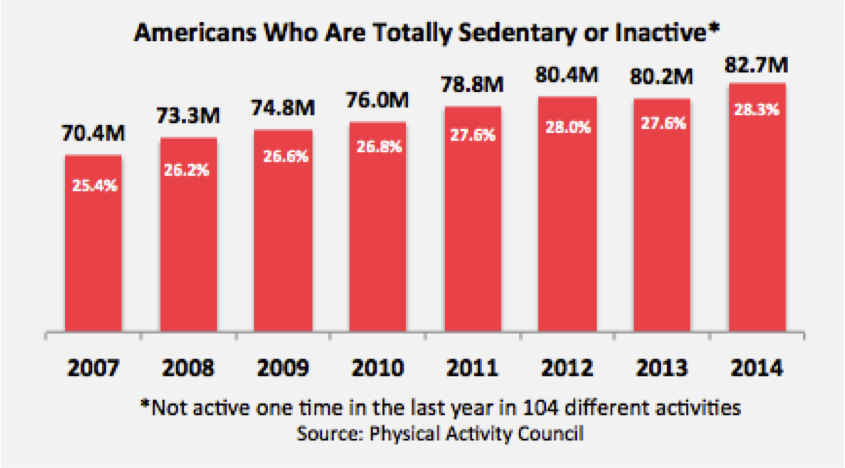
- Currently no states require that at least 50 percent of time spent in physical education be devoted to vigorous- or moderate-intensity physical activity.[1]
- This is not isolated to the United States, as every country has seen declines in physical fitness outcomes over the last decade. [1] This is also coinciding with the increase IN overweight and obese children.
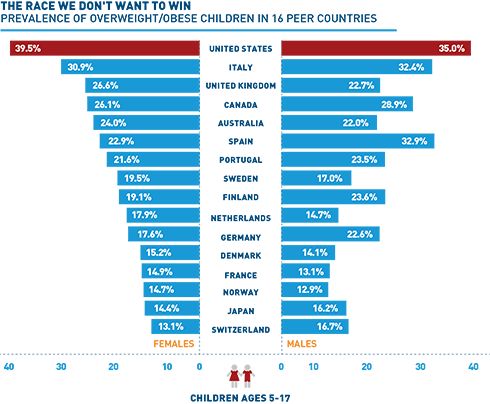
- Sports, which is the most popular way to introduce young children into the world of movement and activity, is declining. [2]

There are several more examples, but you get the idea. This has made me equal parts upset and sad for a long time. I know that sports shaped me growing up, and it directly led to the lifestyle that I retain well into my forties. So, off the heels of our successful adult Challenge that we do every year, the thought occurred, “Why not have a Challenge for kids?” It is a simple formula, active kids do better in the school, are healthier and contribute to society in positive ways as adults.
Consider the following concerning activity and kids:
Active kids get better grades.
Active kids are 1/10 as likely to be obese.
Active kids achieve up to 40% on test scores. Their brains literally light up after activity.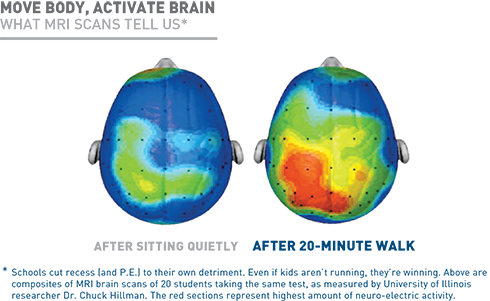
Active kids smoke less and use less recreational drugs.
Active kids are 15% more likely to go to college.
Active kids make more money as adults.
It is clear that physical activity has a multitude of benefits with very few drawbacks. The goal of the kid Challenge (herein referred to as Active Kids) is to promote physical literacy and be an advocate for the introduction and adoption of healthy behaviors, leading to habits for life.
Before we go into the specifics of Active Kids, let’s briefly discuss the phrase physical literacy.
At its core, being physically literate means to have the Ability, Confidence and Desire to be active for life.[2]
Here is a brief description of each of the three components:
Ability refers to competency basic movement skills and an overall fitness that allows individuals to engage in a variety of games and activities. This outcome is achieved through a mix of informal play and intentional teaching of movement skills, among them running, balancing, hopping, skipping, jumping, dodging, throwing, leaping and throwing and general hand-eye coordination activities.
Confidence is knowing that you have the Ability to play sports or enjoy other physical activities.
Desire is the intrinsic enthusiasm for physical activity, whether organized or unstructured, resulting from early positive experiences that are fun and motivate children to do their best.
So, if we as coaches (and parents) can get them to “buy-in” early, we are setting them up for success later.
However, for each year that passes, the likelihood goes down that healthy habits will be utilized.[5] It is unlikely to be a daily routine in school (only 4% of elementary schools offer PE on a daily basis, even though 80% require PE to be a part of the curriculum; that figure goes down to 2% in high school [1]), so the onus falls upon coaches and parents to steer the ship.
With busy lives, less and less “family time” and more and more demands on children than ever, it is a tough sell to get kids to develop and continue healthy behaviors. While it is not the panacea, we feel that there are certain foundational principles that need to introduced and implemented, including Physical, Nutritional, Intellectual and Social categories. A big driver behind the genesis of Active Kids is rewarding behaviors that kids are already doing, not necessarily overhauling their lives.
—————————————————————————————————————————
So, using the above as a backdrop, we are excited to bring Active Kids to ASF in April, 2016. If successful, we will certainly keep it as a regular program.
Here are the specific details:
Dates – April 4-30
Availability – 12 spots, open to new and current clients
Ages – 10-13 years of age, playing sports is not a requirement
Cost – $49
This will be a point system that is based on the above four categories (Physical, Nutritional, Intellectual and Social). For example, for every 30 minutes of silent reading, there would be “x” points; for every 30 minutes of free play, that would be “x” points. There will also be a fun physical Challenge every week.
We encourage you to have your child register for this, especially since they don’t listen to mom and dad anyway :).
If you are interested, registration begins on March 14.
References:
1. IOM (Institute of Medicine). 2013. Educating the student body: Taking physical activity and physical education to school. Washington, DC: The National Academies Press.
2. Sport for All, Play for Life, Aspen Institute.
3. Physical Activity Promotion in the Preschool Years: A Critical Period to Intervene
Gary S. Goldfield, Alysha Harvey, Kimberly Grattan, and Kristi B. Adamo, Int J Environ Res Public Health. 2012 Apr; 9(4): 1326–1342.
4. Active Healthy Kids Canada. Don’t Let This Be the Most Physical Activity Our Kids Get After School: Active Healthy Kids Canada Report on Physical Activity for Children and Youth. Active Healthy Kids Canada; Toronto, ON, Canada: 2011.
5. Developing Physical Literacy, A Guide For Parents Of Children Ages 0 to 12, Canadian Sport for Life.
Glutes = more horsepower, part 2 – Brian MacDonald
In part one, I discussed why we put such an emphasis on training the glutes into our athlete and adult protocols alike. This post will dive into the specific exercises we use and why. We divide our glute exercises into two main categories, standing and lying. Standing variations obviously offer more application to the demands that will be placed on the body on a day to day basis whether you are an athlete or an average Joe. Lying variations allow us to increase the load considerably and are also a great alternative to people with low back issues such as myself. I have to be incredibly conservative when performing standing variations due to my low back, however I can load up a lying variation aggressively while achieving very similar benefits. With that being said lets dive into the top exercises we use for each variation previously mentioned.
1. Lying Barbell Hip Thrust – This is our favorite exercise when targeting the glutes. Two main reasons we love this exercise are the transfer to speed and acceleration with our athletes, and the general improvement in function since the glutes influence so much of the rest of our body mechanics. We have the luxury of having a piece of equipment created for the purpose of this exercise, however it can be performed on any conventional bench. Set up with the bench right around the mid back, this will serve as your pivot point. Maintaining this point is critical as we do not want the back to slide back and forth throughout the exercise. Before getting into bar placement, I will note that a bar pad or padding of some sort will be needed to protect the hips while lifting. Bar placement is right in the crease of the hips which is easily achieved by rolling the bar up over the feet and legs. Bring the feet up towards the butt, the shins should be vertical when the lift is actually perform if this helps. Toes are either straight forward or slightly turned outward. When executing, be sure you are pushing through the heel rather than your toes. Create tension, then lift rather than just jerking into the motion. Each rep should be a controlled smooth movement. The neck should remain neutral through the entire lift. As you approach the top of the movement, contract the glutes without hyperextending the low back, then descend in a controlled motion before repeating. A last note is that this can also be performed as a bridge which you will see at the end of the video.
2. Standing Kettlebell Swing – This is an exercise that packs a huge punch. Though it is a hip based exercise, it really forces you to engage the entire body. The most important point to make is that this is not a squat, at no point throughout the movement should there be any squatting involved. Start by holding the kettle bell with an overhand grip. As you start swinging, the butt goes back and the chest stays up. Think of trying to tap your butt to an imaginary wall behind you when driving the hips back and the kettle bell should end up right between your legs and at no point should the kettle bell drop below the knees. As you drive the hips forward into extension, be careful not to hyperextend the back, rather be sure the shoulders are stacked directly over the hips and contract the glutes on the end range.
3. Mini band monster walks – All we need for this one is a small mini band, or tubing with ankle straps will also work. With the mini band, the lower we place the band on the leg, the more difficult the exercise. Once the band is set, drop the hips into an athletic position. We want constant tension on the band, so be sure the knees are not collapsing inward. If this is the case, a lighter band or placing the band higher may be necessary. Movements will be forward, backwards, and lateral, it really does not matter which one you start with. This exercise, particularly the lateral movements, really targets the gluteus medius as well as any abductor of the hip. As you move, focus on maintaining tension on the band and an athletic position.
As I stated in part one , the gluti are collectively vital to performance and function. There are a number of additional exercises that are very effective in training the glutes, these are three that we feel are very effective in achieving targeted benefits.

